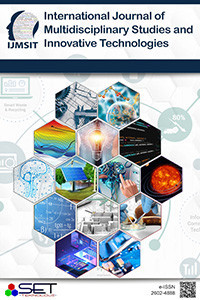Comparison of Three Travel Websites According to Cognitive Load and Usability Metrics Büşra Nur Yetkin1*, N. Fırat Özkan2 , Merve Sert3 and
Comparison of Three Travel Websites According to Cognitive Load and Usability Metrics Büşra Nur Yetkin1*, N. Fırat Özkan2 , Merve Sert3 and
user experience, user testing anova, interface, nasa-tlx, ibm csuq,
___
- [1] Hamurcu, A. “The Role of Industrial Designers in the Birth and Development of User Experience Design in Turkey.” National Design Research Conference, pp. 333-347, 2014, Orta Doğu Teknik Üniversitesi.
- [2] Ulusam Seçkiner, S., and Toraman, N. “A new model for determining cognitive workload. " Journal of Engineering Sciences and Design, 5(1), pp 365-381, 2017.
- [3] Tracy, J. P. and Albers, M. J. “Measuring cognitive load to test the usability of web sites.” In Annual Conference-society for technical communication, 53, p. 256, 2006.
- [4] Hart, S. “Nasa-Task Load Index (NASA-TLX); 20 Years Later.” Proceedings Of The Human Factors And Ergonomics Society Annual Meeting, 50(9), pp 904-908, 2006.
- [5] Conway, D., Dick, I., Li, Z., Wang, Y. and Chen, F. “The Effect of Stress on Cognitive Load Measurement.” In Human-Computer Interaction–INTERACT 2013 pp. 659-666. Springer Berlin Heidelberg, 2013.
- [6] Rizzo, L., Delany, S., Dondio, P., and Longo, L. “Modeling Mental Workload via Rule-based Expert System: a Modeling Mental Workload via Rule-based Expert System: a Comparison with NASA-TLX & Workload Profile.” Dublin: ARROW TU DUBLIN, 2016.
- [7] Şeker, A. “Using outputs of NASA_TLX for Building a Mental Workload Expert System.” Gazi University Journal Of Science, 27(4), pp. 1131-1142, 2014.
- [8] Delice E. “Assessment of mental workloads of emergency physicians using nasa-rtlx method: an application study.” Atatürk University Journal of Economic and Administrative Sciences, 30(3), pp. 645-662, 2016.
- [9] Flemisch, F., and Onken, R. “Open a Window to the Cognitive Work Process! Pointillist Analysis of Man-Machine Interaction.” Cognition, Technology & Work, 4(3), pp. 160-170, 2002.
- [10] Wanyan, X., Zhuang, D., and Zhang, H. “Improving pilot mental workload evaluation with combined measures. Bio-Medical Materials And Engineering", 24, pp. 2283-2290, 2014.
- [11] Střelák, D., Škola, F., and Liarokapis, F. “ Examining User Experiences in a Mobile Augmented Reality Tourist Guide.” Proceedings Of The 9Th ACM International Conference On Pervasive Technologies Related To Assistive Environments, 1-8, 2016.
- [12] Beck, E., Christiansen, M., Kjeldskov, J., Kolbe, N., and Stage, J. “Experimental Evaluation of Techniques for Usability Testing of Mobile Systems in a Laboratory Setting.” In Proceedings of OzCHI, Brisbane, Australia CHISIG, 2003.
- [13] Carstens D.S, and Patterson P. “Usability study of travel websites.” J. Usability Studies 1, 1, pp. 47–61, 2007.
- [14] Groth A., Haslwanter D. “Efficiency, effectiveness, and satisfaction of responsive mobile tourism websites: a mobile usability study.” Information Technology & Tourism 16(2): pp. 201-228, 2016.
- [15] Rusli, N., Hassan, S., and Liau, N. “Usability Analysis of Students Information System in a Public University.” Journal Of Emerging Trends In Engineering And Applied Sciences, 4(6), pp. 806-810, 2013.
- [16] Nielson, J. “Usability Engineering.” 1993.
- ISSN: 2602-4888
- Yayın Aralığı: Yılda 2 Sayı
- Başlangıç: 2017
- Yayıncı: SET Teknoloji
A Serious Game Application For The Detection Of Explosives
MARC: Mining Association Rules from datasets by using Clustering models
Shadi AL SHEHABI, Abdullatif BABA
Keivan BASİRİ, Ehsan AMİRİ, Zahra GHASEMİ, Saeed AMİRİ
Büşra Nur YETKİN, N. Fırat ÖZKAN, Merve SERT, Gülce YÜCEL
Opportunities and Challenges to Educators When Transitioning to a TEL Environment – Case of Kuwait
Behnam ALİZADEHASHRAFİ, Mohammad DARKAHİ GHAREH BAGH, Soraya ATA, İsmail Rakıp KARAŞ
Yalova İçin Binalarda Yalıtım Kalınlığının Simülasyonla Değerlendirilmesi
Hüseyin Can ÜLGÜNER, Adil DEĞİRMENCİ, Ahmet ÜSTÜNTÜRK, Alper KELEŞOĞLU, Ümit ÜNVER
An Essay on the defining Design Process as a Philosophical and Conceptual Term
Asiye Nisa KARTAL, Hasan Basri KARTAL
N. Fırat ÖZKAN, Emre AKSOY, Gökberk ŞENSOY
Principles of John von Neumann as a basis of the Electronic Calculating Machine
